
Hamstring Injuries
By Dr. Koco Eaton
Hamstring injuries are a common sports medicine injury. This, unfortunately, has plagued a number of the Devil Ray baseball players in the past. Hamstrings are a group of muscles that start off in the hip joint, run down the back of the leg and cross the knee joint. Because this muscle crosses two separate joints, a lot of force is applied to these muscles, and therefore it is involved in a number of injuries.
The hamstrings are used in the leg primarily to slow down the knee as the foot swings forward in the running motion. The hamstring elongates as the force is applied to the muscle. This action of extending as the force is applied to the muscle makes the muscle weaker. Due to this mechanical disadvantage, the hamstring is involved in numerous injuries to the athlete.
There are other factors that are involved with hamstring injuries. Inadequate warm-up, inadequate stretching, poor endurance, poor technique, poor posture have all been associated with hamstring pulls. However, one of the other big reasons for hamstring injuries is a muscle imbalance. Many athletes develop the quadriceps muscles or the muscles in front of the thigh. However, the muscles in front of the thigh can become two to three times stronger than the muscles in the back of the thigh. This muscle imbalance contributes to hamstring injuries.
At the time of the injury, the athlete will notice the rapid onset of pain. Occasionally the athlete may report hearing a pop in this area. Oftentimes bruising becomes evident over the back of the thigh 24 to 48 hours after the initial injury. The severity of the hamstring injury is divided into three grades. Grade I hamstring injuries are the mildest. There is no loss of motion of the hip and knee joint, and the athlete returns to sports in about 5 to 7 days. All athletes need to be re-evaluated 24 hours after a hamstring pull. The severity of the hamstring pull cannot be assessed until 24 to 48 hours after the initial injury.
A Grade II hamstring pull is usually associated with a loud audible pop. With a Grade II pull, the muscle actually pulls away from the tendon. More bruising is seen in the back of the thigh. The athlete has a decreased range of motion for the hip and the knee. This is a more severe injury, and the time back to sports is between 4 to 6 weeks.
A Grade III hamstring pull is the most severe type of hamstring pull. In this condition the muscle completely pulls away from the tendon. The athlete will usually feel a large lump in the back of his thigh. This is associated with a significant amount of pain and swelling immediately after the injury. Time back to sports for a Grade III injury is usually 6 to 12 weeks.
The hallmark of treatment for muscle strains is the RICE (rest, ice, compression, elevation) regimen. The primary function of the RICE regimen is to control the swelling. Also, patients with hamstring pulls are initially put on crutches to take the weight off the leg. After three days the patient can start to put gradual weight down on the affected side. Also, nonsteroidal anti-inflammatories can decrease the swelling and lessen the pain associated with muscle pulls.
The key to treating hamstring injuries is proper training techniques to prevent hamstrings injuries from occurring in the first place. Listed in the diagram is a method of stretching the hamstrings. Also, leg curls done lying face-down can strengthen the hamstrings to prevent an injury. Hamstring curls should include doing a set of negative repetitions. This is done by having the knees flexed to 90 degrees while lying face-down and gradually lower the weight taking 4 seconds to lower the weight down so that the knees come completely straight.
